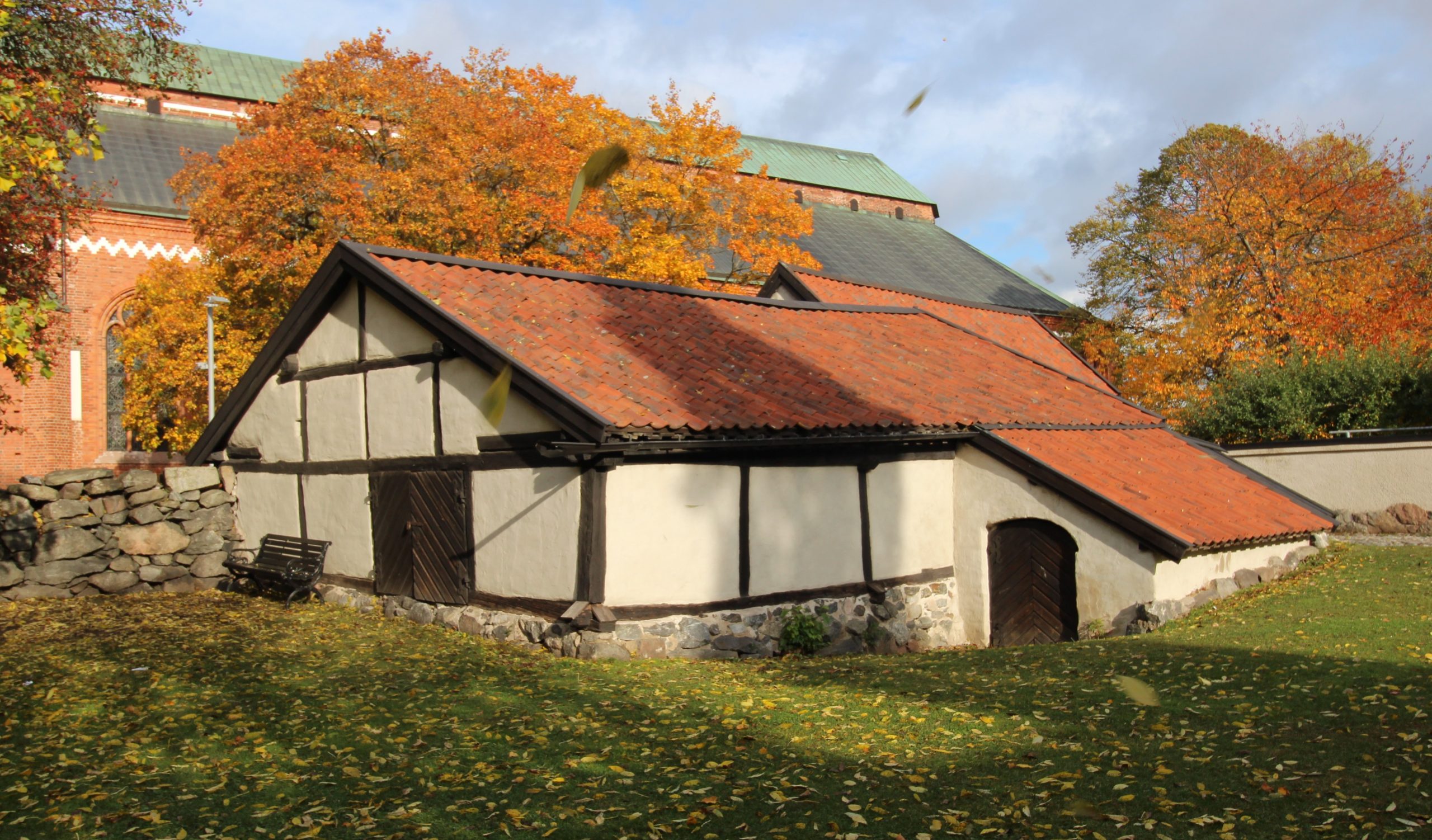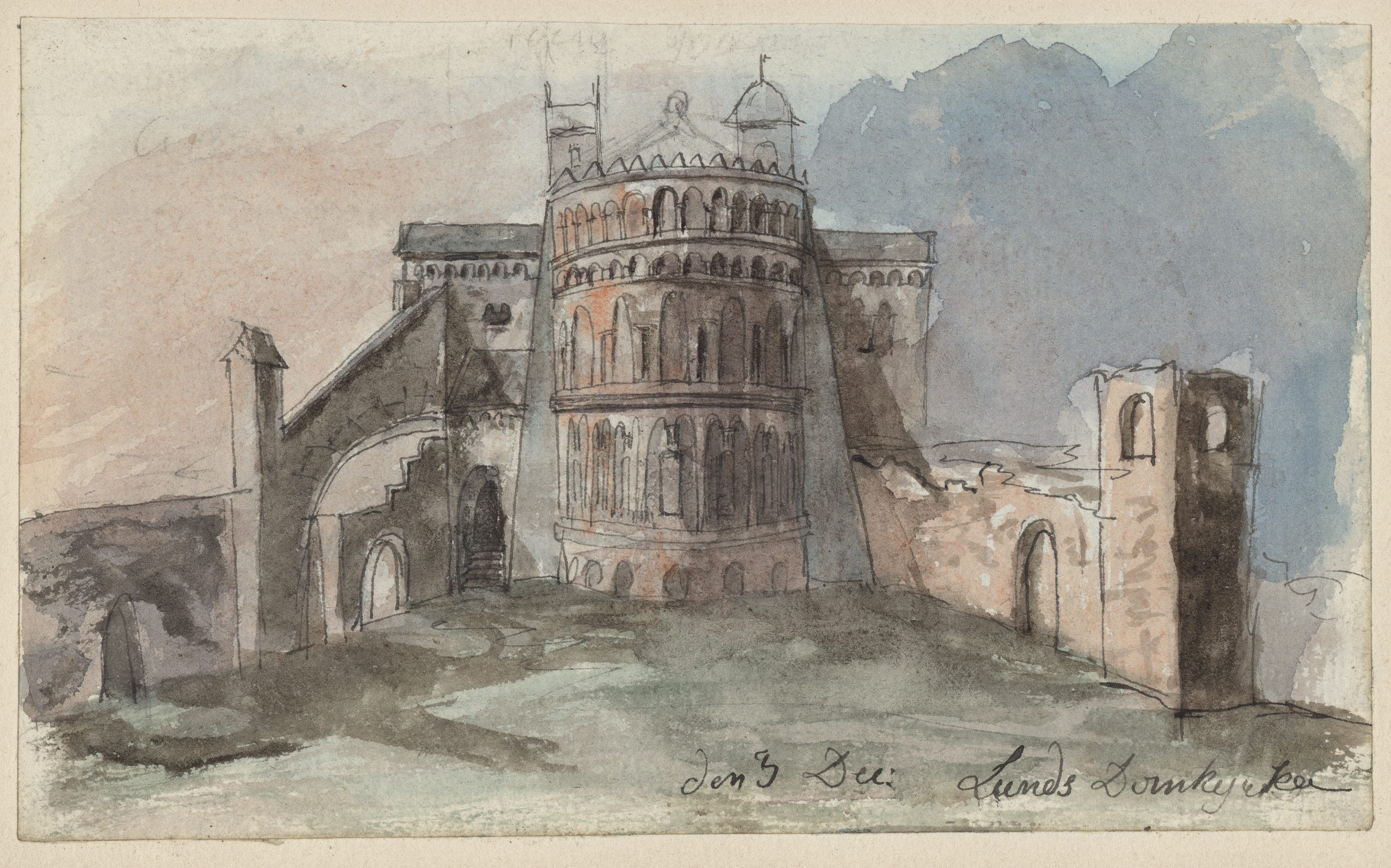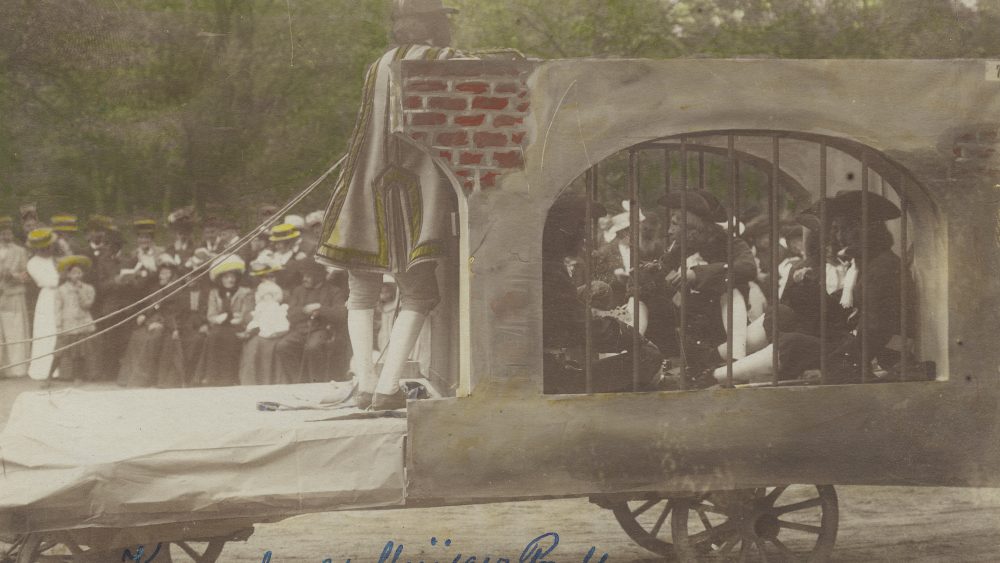Part 1
One of the more tragic events in Lund’s academic history took place on 7 September 1829. Under circumstances that have never been fully clarified, the then theology student and member of the Gothenburg student nation, Jacob Wilhelm Blomdahl, beat to death his fellow student and nation member Anderas Emanuel Landén. For this crime, Blomdahl was sentenced to death by beheading, and as this took place before 1853 – i.e. during the period when Swedish universities still had their own jurisdiction over their employees and students – it was the University’s own board, the consistory led by the vice-chancellor, that passed the death sentence.
This article will not, however, be yet one more account of this crime – what became known as the murder at Locus Peccatorum (the House of Sin) – as this has already been described in detail in at least two books: by the legal historian Kjell Å Modéer in Brott vid Lundagård (1989), and the author K Arne Blom in Skumraskbravader (Old Lund Yearbook 1974). In addition, the murder was just recently the subject of a long edition of the Faculty of Law’s podcast, Öppet fall in which I had the pleasure of acting as a pundit with programme presenter Elsa Trolle Önnerfors. In that particular capacity, I was however asked a question that there and then I could only answer in a somewhat vague and preliminary way. The documents from Blomdahl’s trial state that between interrogations he was detained in the University’s holding cell or lock-up (“proban” in the Swedish of the time), but where exactly was it? Modéer states that it was “in the Academy Building (Kuggis), built in 1802, located east of the King’s House in Lundagård”, whereas according to Blom it was “housed in the city jail in an old stone building south-west of the cathedral on Kyrkogatan”. After taking part in the programme, I have not been able to restrain myself from carrying out further research on the matter, and in the present two-part article I hope to be able to deliver a much more certain answer to this question, but above all tell the whole story of the lock-up in Lund; something that as far as I know has not been done before.

For “negligent priests or disruptive devils”
It should be clarified from the start that the phenomenon of a so-called “proba” – also written as “prubba”, “probba”, “probben” and a number of other variants in Swedish, all deriving from the Latin word for “trial” – is by no means unique to Lund University or even to the Swedish university world in general. The oldest written reference to the word that the Swedish Academy Dictionary has succeeded in finding is from Laurentius Petri’s hand-written draft of church regulations in 1561 (printed in1571), which states, among other things, that a priest who “drinks until intoxicated / to the extent that they are incapacitated / he shall be given a requisite punishment in the Probo etc.”. From this it can be surmised that the “proba” was originally a church prison, intended for the detention of misbehaving priests, and that such lock-ups were found in all bishopric cities, as it was there, of course, that the bishop and cathedral chapter exercised their jurisdiction over church folk. However, the bishopric cities also had the Swedish upper secondary schools of that time, and these were also under the control of the church for a long period. Therefore, the bishopric’s various lock-ups, to quote old Lund professor Ewert Wrangel, came to have the double function of a holding cell for both “negligent priests” and “obstinate pupils”, and it is possible to imagine that over time the latter group – mischievous schoolboys – came to dominate the benches in the lock-ups. The only known preserved lock-up in Sweden – located close to both the cathedral and the Rudbeck upper secondary school’s old main building in Västerås – is also primarily referred to as a “school jail”.

However, the few Swedish universities in olden times were also located in bishopric cities and had strong connections with the church. That is why it is not surprising that the lock-ups in these parts came to be linked with the dominant group of wayward and noisy youths there: the students. The fact that one or two stays in the institution’s detention facilities could almost be seen as a commonplace student activity was indicated by Anna Maria Lenngren’s poem “Biographie”. In this parodic description of a 50-year-old man’s life – written in the first person – the narrator happily depicts their student years thus:
But learning does its labours have,
So as a student, I was quite persistent,
About the city folk, small pamphlets I wrote
Went roaming wild on the streets each night,
And with the fanatical journeymen did fight,
In the Proban you could often see me –
And with the greatest honour I took my degree.
In this poem, Lenngren placed the speaker’s studies in the city where she was born, Uppsala. If he had actually existed, his cell should therefore have been located in the Consistory Building, built in the 1700s, on St Erik’s Square, which has a lock-up on the ground floor. Alternatively, he may have been held in the somewhat later, more well-known holding cell in the so-called cathedral porch stairwell. It is often mentioned in tourist guides and was in use until 1833. Even earlier, there had been a building in the Gustavianum courtyard – also the location of the academic printing house – which acted as Uppsala’s “prubba” (which seems to have been the most common name for it in Uppsala).

Queue for the lock-up
So where was the lock-up in Lund? The answer is that its location, as in Uppsala, shifted over time. That the existence of a lock-up was a presupposition even at the time the University opened is stated clearly in the institution’s oldest policy document, the 1666 constitution; among other things from the rule that the key to the jail was among the things that were to be ceremonially handed over at every change of vice-chancellor. A practical problem, however, was that the young institution in its first 20 years did not own any of its premises. Thus, it was always a question of being totally dependent on borrowing premises from others, and it was mainly from the church. It is therefore logical that the very first student jail came to be housed in the basement of the medieval Chapter House, a building long since demolished, which stood in Kraft Square – then a churchyard – semi-detached to the cathedral’s north-east corner. On the upper floor was the cathedral chapter’s meeting room, but in the cellar, space was prepared for the newly opened University’s lock-up. In his University history published in 1868, Martin Weibull gave the following description of the premises and their use at the time:
The lock-up consisted of an arched cellar in the Kraft churchyard, somewhat raised above ground. It was equipped with doors strengthened with iron bands and had iron bars for windows. It could not hold many people at the same time, so when in 1708 18 to 20 students were sentenced to jail at the same time for nocturnal disturbances, wearing disguise in public, noise and violence during the spring market, the lock-up could not take them all, so that the most guilty had to serve their time before the less guilty could be admitted.
The fact that the lock-up was extremely overburdened at times should not be interpreted as the students being thoroughly engaged in criminal behaviour. It was not only breaking general Swedish law that could lead to a stay in the lock-up, but also contraventions of the University’s numerous internal rules of conduct. The offences that could lead to detention in the lock-up included mooching around the city on Sundays instead of going to mass, playing cards and dice, and failing to appear if called to an interrogation with the vice-chancellor. However, the most common reason why the students of that time ended up in the lock-up would probably have been – as in the example from 1708 above – generally rowdy behaviour, especially at night and under the influence of distilled spirits from the city’s many taverns. It was again Martin Weibull who, in a separate essay in 1877, suggested that “the young students’ source of amusement in the 1720s was to wander around the university city in large groups with swords at their side and loaded rifles in hand”, when they would, while singing and bawling, shoot with both powder and shot over the inflammable thatched roofs. It is therefore mainly for this type of “wild, mischievous antics” that the records of the time show students sentenced to a few days’ detention in the lock-up.

How common these antics and subsequent spells in the lock-up were in the late 1600s and early 1700s can be gleaned indirectly from sources such as the annual report that the mathematics professor Anders Spole published when he relinquished the role of vice-chancellor he had in the autumn semester of 1672. He expressed his gratitude for the “academic youths’ calm and dignified behaviour, that has so characterised this half-year, that during this time no public complaint against these youths has been made and there has been no need for any punishment” – something that would scarcely have been worth mentioning if it had not been more the exception than the rule.
The fact that the academic youths were far from always behaving in a “calm and dignified” manner can also be seen from details of the reactions to being sentenced to detention in the lock-up. The locking up of a student often led to loud and occasionally even physical protests from their fellow students. The lock-up’s “lock and doors were often broken”, recounted Weibull, and there were instances when things could get even more furious. There are witness accounts from 1675 that students literally stormed the premises armed with axes and other weapons, and in 1704 a dissatisfied and armed group of students behaved so threateningly that the lock-up guard felt compelled to escape to the vice-chancellor’s residence!
On other occasions, however, the punishment was taken in a more easy-going way. There are actually accounts stating that large groups of students often chose to visit a locked-up fellow student for regular organised parties in the cell. This was done, for example, by the Skåne student nation in May 1689 when one of its members “Monsieur Bergsteen was in the lock-up”. The party cost 7 crowns and 17 pence. Not surprisingly, “drinking and noise” could result from these, let us call them “internal” gatherings, and in 1692 things got particularly out of hand. The guard on duty had not only let the carousing students into the cell but had also “sat in the lock-up and after a lot of drinking was excessively drunk”. The party ended with the guests removing the cell door from its hinges! These conditions were hardly specific to the fledgling Lund University, as attested by the Uppsala University historian Claes Annerstedt, who wrote regarding the situation in the city at the time that “the student lock-up […] is almost considered to be a place of amusement”. The Lund professors even discussed among themselves the possibility of fining students instead of sending them to the lock-up “which is only an occasion for scandal and other things”.

The city and University look for a joint solution
According to some sources at least, the lock-up in the Chapter House shared the same cellar as the city of Lund’s civil prison, known as the “hag hole”, which led Andreas Manhag in his book Kraftstorg – Lunds mittpunkt och baksida under 500 år (2017) to describe the place “not only as a centre for the cathedral chapter and the University, but also as Lund’s prison”. At the same time, there is other information, including that in William Karlsson’s book Stadsvakt och poliskår i Lund (1950), which indicates that the city’s prison was for some of this period at least located at the city hall on the main square, Stortorget, rather than at the Chapter House. The last-mentioned information is, however, somewhat vague and contradictory.
Regardless of the extent to which the city and University were “cellmates” as far back as the 1600s, it is however quite clear that in the following century there was a search for joint detention solutions. This is recounted by the previously mentioned William Karlsson in his book. In addition to the longstanding problem of the city’s detention facilities being in bad condition and far too easy to escape from, the question of collaborating with the University became pertinent because there were no special premises for members the city guard – a type of police force comprising staff from both the city and University. Such premises, as stated in correspondence between the city and the University in 1739, were needed for the guards, during extremely cold periods for example, but also to make it easier for the public to find and contact the guards. Not least, this would also prevent the guards from “seeking out other places” (i.e. taverns) in order to “neglect their duties” there. And such premises could also include joint detention facilities.
No practical collaboration seems to have arisen from the contacts at that time, and the city in due course solved the detention facility problem by renting and furnishing a cell in the cathedral crypt – which during this period occasionally flooded! A few years later, the University found what was by all accounts a better solution. In 1764, the institution became the sole owner of Liberiet, the cathedral’s still extant old library building on the south side of the Kraft churchyard. The upper floor had previously been used as a lecture hall, but it was now renovated and refurbished as a fencing hall for the University’s fencing master, and two small rooms were created adjacent to this hall: an office for the fencing master and a new lock-up. With its location one floor up, this should not in any case have been troubled by floods (the building’s extensive but dark cellar, which you would otherwise spontaneously think could have been suitable for the purpose did not however have a clear use before the 1830s, when it was refurbished as storage facilities for the University’s fire-fighting equipment).

The question, however, is how much did the University use its new lock-up in the following decades. According to Weibull, the number of detained students fell considerably in the second half of the 1700s. His explanation was “greater education and refinement” among the students. Perhaps it was also the case that the University management chose to turn a blind eye to some of the rules and prohibitions that remained from the 1600s, but which were starting to be regarded as obsolete. In any event, this meant that the lock-up was rarely used for its original purpose and on occasion it was used for something else entirely – namely as the University’s lime store.
Around 1800, however, the number of punished students rose again. It is also a period for which the sources and literature are most unclear and contradictory concerning where the lock-up was actually located. I will try to provide an answer to this question in part 2 of this article, when we will get to know some of the very last individuals who were to shake the bars of the lock-up.
Fredrik Tersmeden
Archivist at the University Archives (and unpunished to date)
Thank you to archivist Johan Sjöberg at the Uppsala University Library who assisted me with advice on literature about the history of the Uppsala lock-up.

